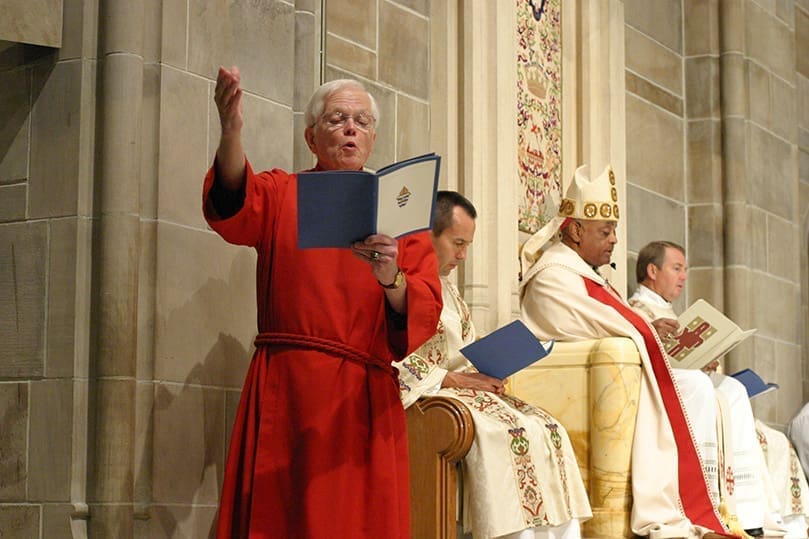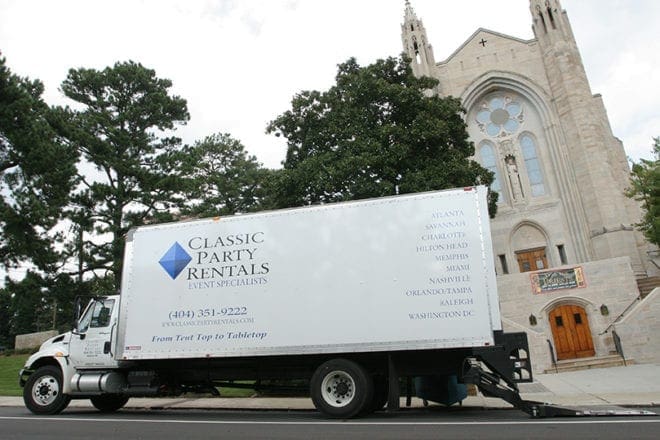 Photo By Michael Alexander
Photo By Michael AlexanderAtlanta
Cathedral hosts historic day with aplomb
By GRETCHEN KEISER, Staff Writer | Published October 1, 2009
When you’re 70 years old, can you experience something momentous that you’ve never experienced before?
Yes, if you’re the Cathedral of Christ the King.
September 29, 2009, was a day of uncommon history for the Archdiocese of Atlanta, unfolding in the 1939 church.
For the first time, the Cathedral hosted a bishop’s ordination Mass, as Bishop Luis R. Zarama was ordained as Atlanta’s auxiliary bishop. Archbishop Wilton D. Gregory, the consecrating bishop at the Mass, ordained a bishop for the first time in his life. Second-Ponce de Leon Baptist Church, neighbor to the Cathedral across East Wesley Road, opened its doors so more people than fit in the Cathedral could watch the ordination televised live on a screen in the Baptist sanctuary. In this apparently unprecedented moment, Catholics participated fully in the Mass there through the neighborliness of the Baptist pastor, Dr. David Sapp. Priests came over at the time of Communion to distribute the Eucharist.
“We’re thrilled to have the opportunity to work together,” Dr. Sapp said. “We have had a good relationship for a long time. … There is too much of people emphasizing what makes us different. We kind of like the opportunity to emphasize what makes us the same.”
“I grew up in Savannah in an era when this kind of cooperation was non-existent,” he continued. “It is wonderful that this kind of thing has happened. I think it is enriching of the faith and not destructive of the faith.”
The most reverent and traditional elements of the solemn event flowed seamlessly with what was unique and contemporary, like the broadcasting of the Mass with commentary by Father Paul Berny on Atlanta Interfaith Broadcasters from a reconciliation room at the Cathedral. The broadcast was carried on cable stations as well as in overflow areas in the Cathedral parish hall and Baptist church.
Even the music ranged from the most ancient to the most contemporary.

(L-r) Alison McGowan, Jane Murray, Cathedral of Christ the King Flower Guild volunteer co-chair, and Helen Young place the altar flowers in buckets of water in preparation for their use on the Cathedral of Christ the King altar. Photo By Michael Alexander
The Cathedral choirmaster, Kevin Culver, said he was impacted by the unique aspects of this ordination, unlike priest ordinations and unlike the installation liturgies for archbishops of Atlanta, who were already ordained bishops when appointed here.
Two very ancient pieces of music were sung during the Mass: “Veni Creator Spiritus” and the “Te Deum.”
“All of the music for the ordinary of the Mass is more or less contemporary. … On either side are two of the most ancient chants of the church. . . . The ‘Te Deum’ is from the 300s A.D. The ‘Veni Creator Spiritus’ is only from the eighth century,” Culver said.
Other noteworthy musical aspects of the Mass were a psalm composed for the Cathedral by contemporary composer Richard Proulx several years ago for the Chrism Mass. Culver said incorporating it into this Mass pleased him as it is a very meaningful part of the musical history of the Cathedral and Proulx a distinguished church composer. Hamilton Smith, Cathedral music director, composed antiphons for the vespers service the night before when archdiocesan priests gathered with the bishop-elect.
The “Cantique de Jean Racine” by Gabriel Faure was sung at the offertory; its “beautiful, beautiful melodies” touched the bishop’s mother when the Cathedral Choir sang it at Mass when then Father Zarama was made a monsignor.
“One of the first things he asked we do was that, because his mother liked it,” Culver said.
The Spanish contemporary hymn, “Pescador de Hombres,” (Fisher of Men) was also requested by Bishop Zarama, and that was complemented by a Gregorian chant at another point in the Mass that echoed the words of Christ in Latin, “Come follow me and I will make you fishers of men.”
Handbells and the organ, played by Timothy Wissler, supported the 32 members of the choir, who sang at the Mass and vespers service.

A party rental truck parks in front of the Cathedral of Christ King, where it unloaded tables and chairs for the reception that followed the Sept. 28 solemn vespers service. The Atlanta cathedral was the host of two days of activities surrounding the ordination of Bishop Luis Zarama. Photo By Michael Alexander
“Each person is a very important part. They take their commitment very seriously,” Culver said of the choir, and all were there for the historic Mass.
Beyond the fulfillment of using their musical skills and gifts, Culver said he and others in the choir are touched by the magnitude of the event and by Bishop Zarama.
“I think he is a wonderful guy. I think he is a wonderful choice,” Culver said. “Besides liking him very much, I think what it says about the Atlanta Archdiocese makes you feel good—that we have grown so much that we have this need (for a second bishop) and that the universal church recognizes this need. It feels good. It is nice to see it have this imprimatur. … Yes, you are big enough and active enough and important enough to need this help.”
Volunteers at the Cathedral who form its one-year-old floral guild drew inspiration from the feast of the day and from the bishop’s homeland in Colombia, South America, where over 3,000 varieties of orchids grow and where orchids are the national flower.
Linda Seitz, a coordinator of the guild, said with floral designer Jill Helmer, they chose seven types of orchids for the arrangements in white, yellow and gold, colors that also reflected the feast day Sept. 29 of the archangels Michael, Gabriel and Raphael. Custom floral containers were made to fit on the four small ledges at the foot of the crucifix behind the altar, allowing the largest installation of flowers there in the history of the Cathedral, she said. A flowing arrangement of gold and white orchids also draped the ambo. Lilies and roses at the St. Joseph altar and Mary altar, where orchids were also arranged, were chosen to reflect purity, innocence and the glories of Mary.
“The Cathedral was blessed to have the beauty and glory of these very special flowers for the celebration. St. Paul taught that from the visible things of creation, we can know the invisible things of God,” Seitz wrote of their efforts.
Father Frank McNamee, pastor, said, “it is a great day of rejoicing” at the Cathedral in its 70th year.